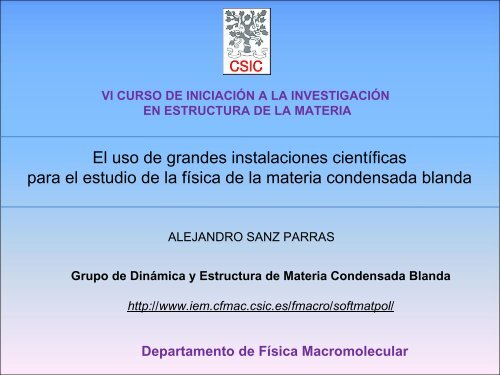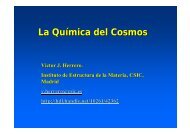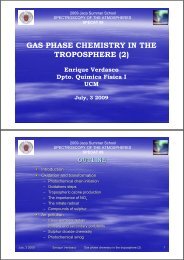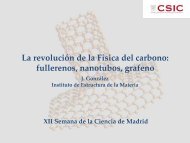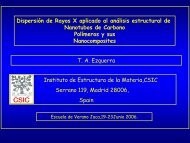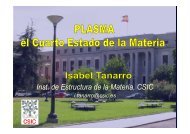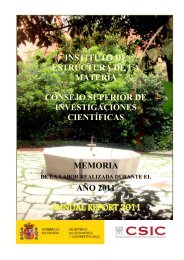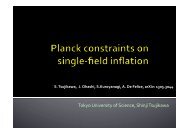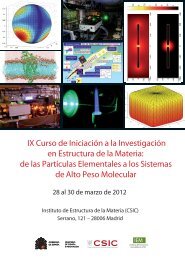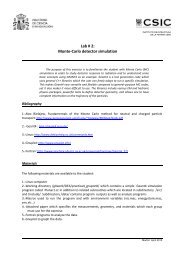grandes instalaciones cientÃficas - Instituto de Estructura de la Materia
grandes instalaciones cientÃficas - Instituto de Estructura de la Materia
grandes instalaciones cientÃficas - Instituto de Estructura de la Materia
- No tags were found...
Create successful ePaper yourself
Turn your PDF publications into a flip-book with our unique Google optimized e-Paper software.
VI CURSO DE INICIACIÓN A LA INVESTIGACIÓNEN ESTRUCTURA DE LA MATERIAEl uso <strong>de</strong> <strong>gran<strong>de</strong>s</strong> <strong>insta<strong>la</strong>ciones</strong> científicaspara el estudio <strong>de</strong> <strong>la</strong> física <strong>de</strong> <strong>la</strong> materia con<strong>de</strong>nsada b<strong>la</strong>ndaALEJANDRO SANZ PARRASGrupo <strong>de</strong> Dinámica y <strong>Estructura</strong> <strong>de</strong> <strong>Materia</strong> Con<strong>de</strong>nsada B<strong>la</strong>ndahttp://www.iem.cfmac.csic.es/fmacro/softmatpol/Departamento <strong>de</strong> Física Macromolecu<strong>la</strong>r
• GRANDES INSTALACIONES CIENTÍFICAS: FUENTES DE NEUTRONESY DE LUZ SINCROTRÓN• MATERIA CONDENSADA BLANDA• APLICACIONES DE LA RADIACIÓN DE NEUTRONES Y DE LA LUZSINCROTRÓN A LA FÍSICA DE LA MATERIA CONDENSADA BLANDA
GRANDES INSTALACIONES CIENTÍFICAS• Insta<strong>la</strong>ciones científicas excepcionales• Surgen para dar servicio a <strong>la</strong>s necesida<strong>de</strong>s <strong>de</strong> <strong>la</strong> comunidad científica y<strong>de</strong> <strong>la</strong> sociedad en general• Afrontan retos científicos que requieren un alto esfuerzo tecnológico• Se estimu<strong>la</strong> <strong>la</strong> co<strong>la</strong>boración internacional• Se requiere una alta inversión: dinamizadores <strong>de</strong> <strong>la</strong> economía
GRANDES INSTALACIONES CIENTÍFICASREALIZACIÓNDELEXPERIMENTOANÁLISIS DELOS DATOSPUBLICACIÓN ?
GRANDES INSTALACIONES CIENTÍFICASFUENTES DE NEUTRONES- Estado estructural <strong>de</strong>l materialEl neutrón como prueba- Dinámica microscópica con informacióngeométrica y temporal- <strong>Estructura</strong>s magnéticas- longitu<strong>de</strong>s <strong>de</strong> onda entre 0.1 y cientos <strong>de</strong> ÅCaracterísticas <strong>de</strong>l neutrón- masa = 1.6 x 10 -27 Kg-carga neutra-espín 1/2- interacción con los núcleos atómicos
GRANDES INSTALACIONES CIENTÍFICASFuente <strong>de</strong> espa<strong>la</strong>ciónFUENTES DE NEUTRONESprotones alta energíadiana <strong>de</strong> átomospesados (W, Hg)neutrones <strong>de</strong> alta energía (MeV)proceso <strong>de</strong> mo<strong>de</strong>ración,enfriamiento o ralentización(D 2O, CH 4, H 2…)conducción <strong>de</strong> los neutrones hacia <strong>la</strong>s guías experimentales
GRANDES INSTALACIONES CIENTÍFICASReactor nuclearFUENTES DE NEUTRONESreacción en ca<strong>de</strong>na <strong>de</strong> fisión <strong>de</strong> uranio enriquecido U 235Ba 141U 235 U 236 Kr 92neutronescalientes (MeV)
GRANDES INSTALACIONES CIENTÍFICASReactor nuclearFUENTES DE NEUTRONES<strong>Instituto</strong> Laue-Langevin (Grenoble, Francia)
GRANDES INSTALACIONES CIENTÍFICASFUENTES DE NEUTRONESFuente <strong>de</strong> espa<strong>la</strong>ciónReactor nuclear ISIS (Oxford, Reino Unido) ORNL (Tennessee, Estados Unidos) LANSCE (Los A<strong>la</strong>mos, Estados Unidos) SINQ (Villigen, Suiza) <strong>Instituto</strong> Laue-Langevin (Grenoble, Francia) Laboratorio Leon Brillouin (Sac<strong>la</strong>y, Francia) FRM-II (Munich, Alemania) <strong>Instituto</strong> Bragg, ANSTO (Australia) J-PARC (Ibaraki, Japan)Debrecen (Hungría) ?FUENTE DE ESPALACIÓN EUROPEA (ESS)Lund (Suecia) ?Bilbao (España) ?
GRANDES INSTALACIONES CIENTÍFICASLUZ SINCROTRÓNRadiaciónsincrotrón1901-198816 Premios Nobelre<strong>la</strong>cionados con los raxos xEUROPAAlemaniaDinamarcaEspañaFranciaItaliaReino UnidoSueciaSuizaASIACorea <strong>de</strong>l SurChinaIndiaJapónSingapurTaiwánAustraliaAMÉRICAEstados UnidosCanadáBrasil
GRANDES INSTALACIONES CIENTÍFICASLUZ SINCROTRÓNSINCROTRÓN ALBA (Barcelona)(en fase <strong>de</strong> construcción)http://www.cells.es/
GRANDES INSTALACIONES CIENTÍFICASLUZ SINCROTRÓN‘Non Crystalline Diffraction for life and material sciences with modu<strong>la</strong>r microfocus option onALBAPresentada en Diciembre 2004 Aprobada en Mayo 2005SINCROTRÓN ALBA (Barcelona)(en fase <strong>de</strong> construcción)Primeros usuarios en 2010!!!http://www.cells.es/
GRANDES INSTALACIONES CIENTÍFICASILLESRFGrenoble, Francia
MATERIA CONDENSADA BLANDA No son simples líquidos No son simples sólidos cristalinos• Importancia <strong>de</strong> <strong>la</strong>s longitu<strong>de</strong>s <strong>de</strong> esca<strong>la</strong> intermedias (<strong>de</strong>cenas <strong>de</strong> nanómetros)• Gran número <strong>de</strong> grados <strong>de</strong> libertad con interacciones muy débiles entre <strong>la</strong>sunida<strong>de</strong>s estructurales. Son sistemas en continuo movimiento al azar Browniano(((((((((((((((((((((((((((((((( ((((((Auto-organizaciónentropíaentalpía
MATERIA CONDENSADA BLANDAPOLÍMEROSCRISTALESLÍQUIDOS
MATERIA CONDENSADA BLANDAPOLÍMEROSMEMBRANASCRISTALESLÍQUIDOS
MATERIA CONDENSADA BLANDAPOLÍMEROSMEMBRANASSISTEMASFORMADORESDE VIDRIOCRISTALESLÍQUIDOS
LA DISPERSIÓN DE NEUTRONES Y LA MATERIA CONDENSADA BLANDA• dinámica <strong>de</strong> <strong>la</strong> ca<strong>de</strong>na (Spin echo, dispersión quasielástica)• movimiento <strong>de</strong> grupos <strong>la</strong>terales (dispersión cuasielástica)• conformación <strong>de</strong> <strong>la</strong> macromolécu<strong>la</strong> (dipersión <strong>de</strong> neutrones a ángulo bajo)• superficies e interfases (reflectividad <strong>de</strong> neutrones)Estado amorfoEstado cristalino• estructura cristalina (difracción <strong>de</strong> neutrones)• morfología cristalina (SANS)• conformación <strong>de</strong> <strong>la</strong> macromolécu<strong>la</strong> (dispersión <strong>de</strong> neutrones a ángulo bajo)• vibraciones cristalinas (dispersión inelástica <strong>de</strong> neutrones)
LA DISPERSIÓN DE NEUTRONES Y LA MATERIA CONDENSADA BLANDAr rk i,E ir rk f , EθfdΩQ r2∂ σ∂Ω∂E∝S(Q,ΔE)E= hω =E i− E ftransferencia <strong>de</strong> energíaE = 0 → dispersión elástica(estructura)E ≠ 0 → dispersión inelástica(excitaciones, dinámica)Q( − )= transferencia <strong>de</strong> momento (distancia <strong>de</strong> corre<strong>la</strong>ción)k ik f4π Q = senλ( θ )Q=2πd
LA DISPERSIÓN DE NEUTRONES Y LA MATERIA CONDENSADA BLANDAAMORFOCRISTALDIFRACCIÓN DE NEUTRONES(estructura)DISPERSIÓN CUASIELÁSTICA(dinámica: tiempo <strong>de</strong> re<strong>la</strong>jación,geometría)A. Sanz, M. Jimenez-Ruiz, A. Nogales, D. Martin y T.A. Ezquerra. Physical Review Letters, (2004) Vol. 93, 1, 015503A. Sanz, H.C. Wong, J. F. Doug<strong>la</strong>s y J. T. Cabral. Journal of Physics Con<strong>de</strong>nsed Matter, (2008) Vol. 20, 104209-7
LA DISPERSIÓN DE RAYOS X (SINCROTRÓN) Y LA MATERIA CONDENSADA BLAN Estudio <strong>de</strong> su dinámica- Dinámica lenta (espectroscopia <strong>de</strong> corre<strong>la</strong>ción rayos x, XPCS)- Dinámica rápida (dispersión inelástica <strong>de</strong> rayos x, IXS) Estudio <strong>de</strong> <strong>la</strong> estructura: técnicas en el espacio recíproco- <strong>Estructura</strong> corto alcance (dispersión <strong>de</strong> rayos x a ángulo alto, WAXS)- <strong>Estructura</strong> <strong>la</strong>rgo alcance (dispersión <strong>de</strong> rayos x a ángulo bajo, SAXS) Estudio <strong>de</strong> <strong>la</strong> estructura: técnicas en el espacio real- Microtomografía <strong>de</strong> rayos x (imágenes 3D con resolución 0.3 – 30 μm)
LA DISPERSIÓN DE RAYOS X (SINCROTRÓN) Y LA MATERIA CONDENSADA BLANCristalización <strong>de</strong> polímeros en tiempo real: efectossobre <strong>la</strong> dinámica <strong>de</strong> <strong>la</strong> fase amorfa remanenteel uso <strong>de</strong> técnicas simultáneasSAXSWAXSEspectroscopiadieléctrica(corre<strong>la</strong>ciones <strong>la</strong>rgo alcance)(fracción cristalina)(fenómenos <strong>de</strong> re<strong>la</strong>jación)10 nm
LA DISPERSIÓN DE RAYOS X (SINCROTRÓN) Y LA MATERIA CONDENSADA BLANel uso simultáneo <strong>de</strong> técnicas <strong>de</strong> difracción y espectroscopia dieléctrica:cristalización <strong>de</strong>s<strong>de</strong> el estado vítreo <strong>de</strong> PBIDS WAXS SAXST = 333 K
LA DISPERSIÓN DE RAYOS X (SINCROTRÓN) Y LA MATERIA CONDENSADA BLANAmorfo inicialRAPPrimer régimen <strong>de</strong>cristalizaciónSegundo régimen <strong>de</strong>cristalizaciónRe<strong>la</strong>jación α restringida dinámicamenteA. Sanz, A. Nogales, N. Lotti y T. A. Ezquerra . Polymer. (2006) 47, 1281
Grupo <strong>de</strong> dinámica y estructura <strong>de</strong> <strong>la</strong>materia con<strong>de</strong>nsada b<strong>la</strong>nda• Tiberio EzquerraMari Cruz García• Jaime Hernán<strong>de</strong>zAmelia Linares• Aurora NogalesDaniel Rueda• Alejandro SanzDepartamento <strong>de</strong> Física Macromolecu<strong>la</strong>r. <strong>Instituto</strong> <strong>de</strong> <strong>Estructura</strong> <strong>de</strong> <strong>la</strong><strong>Materia</strong>
Grupo <strong>de</strong> dinámica y estructura <strong>de</strong> <strong>la</strong>materia con<strong>de</strong>nsada b<strong>la</strong>nda
PARA MÁS INFORMACIÓN¡ CONTACTA CON NOSOTROS!asanz@iem.cfmac.csic.eshttp://www.iem.cfmac.csic.es/fmacro/softmatpol/


